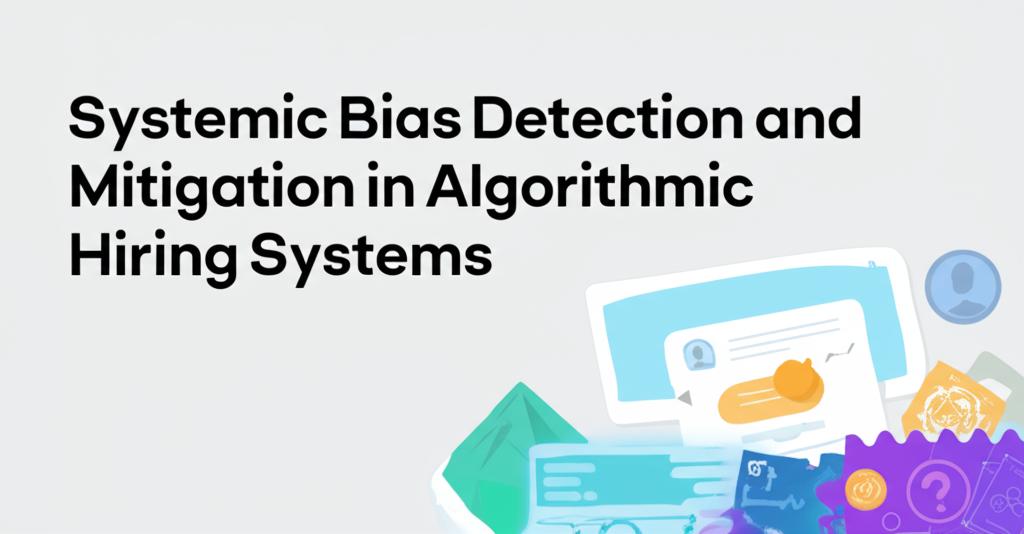Artificial intelligence (AI) is rapidly reshaping the recruitment landscape, offering tools that promise efficiency, reduced time-to-hire, and enhanced candidate analysis. However, these algorithmic hiring systems, designed to streamline processes like resume screening and candidate matching, carry a significant risk: systemic bias. This bias refers to repeatable errors within the system that lead to unfair outcomes, often disadvantaging specific demographic groups based on factors like gender, race, or age. Instead of eliminating human prejudice, poorly designed or implemented AI can inadvertently inherit, replicate, and even amplify existing societal and historical biases.
Understanding the Roots of Algorithmic Bias in HiringBias can creep into AI hiring tools through several avenues:
- Biased Training Data: AI models learn from data. If the historical hiring data used for training reflects past discriminatory practices or lacks representation of diverse groups, the AI will learn and perpetuate these patterns. For instance, Amazon famously scrapped an AI recruiting tool that penalized resumes containing words associated with women because it was trained primarily on resumes from male candidates submitted over a decade.
- Algorithmic Design: The choices made by developers when designing the algorithm, including the features selected for evaluation and how they are weighted, can introduce bias. Developers' own unconscious biases can also unintentionally influence the system's design.
- Proxy Discrimination: Sometimes, algorithms use variables that seem neutral but strongly correlate with protected characteristics (like race or gender), leading to discriminatory outcomes indirectly.
- Interpretation Bias: Even if the data and algorithm are relatively sound, human interpretation of the AI's output can be influenced by pre-existing biases.
Allowing bias in algorithmic hiring isn't just unfair; it damages diversity initiatives, excludes qualified talent, undermines organizational reputation, and carries significant legal and ethical risks. As AI regulations evolve globally (e.g., EU AI Act, NYC Local Law 144 requiring bias audits), compliance becomes increasingly critical.
Detecting Systemic BiasIdentifying bias requires proactive and ongoing effort. Key detection strategies include:
- Regular Bias Audits: Conducting periodic audits, both internally and by engaging third-party experts, is crucial. These audits test the AI system's performance across different demographic groups to identify disparities in outcomes. Tools like IBM's AI Fairness 360 or Google's What-If Tool can assist in measuring fairness metrics.
- Monitoring and Evaluation: Continuously monitor the AI system's performance and impact after deployment. Track hiring outcomes to ensure fairness goals are being met and identify any emerging biases over time.
- Transparency and Explainability: Strive for transparency in how AI tools make decisions. Understanding the 'why' behind an AI recommendation helps in spotting potential biases.
Mitigating bias is a multifaceted challenge requiring a combination of technical and procedural approaches:
- Diverse and Representative Data: The foundation of fairer AI is high-quality, diverse training data that accurately reflects the talent pool you wish to attract. This involves actively working to counteract historical imbalances through techniques like data augmentation or re-weighting samples.
- Fairness-Aware Algorithms: Utilize or develop algorithms specifically designed with fairness in mind. This can involve implementing fairness constraints during training or using techniques like adversarial debiasing, where models are challenged to minimize bias.
- Blind Recruitment Techniques: Configure AI systems to anonymize applications during initial screening, removing information like names, gender, age, or ethnicity that could trigger bias.
- Human Oversight and Hybrid Approaches: AI should augment, not entirely replace, human judgment in critical decisions. Maintain human oversight throughout the process, especially in final decision-making stages, combining AI efficiency with human nuance and contextual understanding.
- Ethical Guidelines and Governance: Establish clear AI governance frameworks and ethical guidelines for the development and use of hiring tools. Ensure principles like fairness, accountability, and transparency (FAT) are embedded in the process.
- Diverse Development Teams: Ensure the teams building and evaluating AI hiring tools are diverse. Different perspectives help identify and address potential biases that homogenous groups might overlook.
- Continuous Improvement: Treat bias mitigation as an ongoing process, not a one-time fix. Regularly update algorithms, retrain models with refreshed data, and adapt strategies based on monitoring and audit results.
While AI offers powerful capabilities to enhance recruitment, its potential benefits can only be fully realized if deployed responsibly. Eliminating bias entirely is a significant challenge, partly because bias can be deeply embedded in societal data and human processes. However, by implementing robust detection methods, employing thoughtful mitigation strategies, maintaining human oversight, and fostering a commitment to fairness and transparency, organizations can harness AI to build more equitable and effective hiring processes, ultimately leading to a more diverse and capable workforce.

